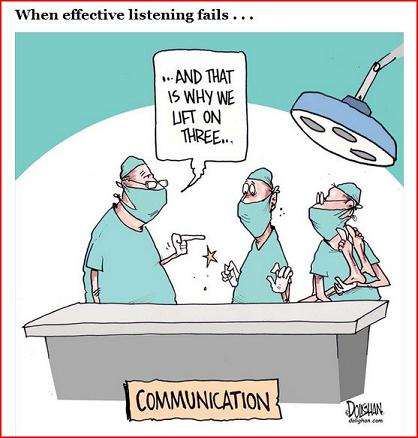

He is careful to make it clear from the outset that being empathetic is a “complex, demanding, and strong-yet also subtle and gentle-way of being” (Rogers, 1980, p.
#EFFECTIVE LISTENING TRAINING HOW TO#
This video by Roma Sharma provides examples of autobiographical listening and empathic listening and how to prepare to be a deep listener.Ĭarl Rogers, a humanistic psychologist, described empathy at great length. The empathic listener begins with the intent to immerse themselves fully in the other person and what they are experiencing.Īpplying empathic listening techniques includes emptying ourselves of the need to be right and our individual autobiography, as our personal narratives may interfere with the speaker’s story (Covey, 2020). This type of listening includes the mechanics of active listening and takes the listener a step further. The active listener’s demeanor helps the speaker feel respected (Hybels & Weaver, 2015). Some characteristics of active listeners include good eye contact, undivided attention, and patience. The listener then confirms the content of what was heard and the feelings the speaker projects about the message (Hybels & Weaver, 2015). This listening method focuses entirely on what the other person is saying. Active listeningĪctive listening is identified as a way of listening instead of a type of listening. Some require more skill and patience than others. In the field of communication, there are various types of listening. Empathic listening is also effective when emotions are running high, when either party doesn’t feel understood, or when there is low trust in the relationship. Leal (2017) suggests using empathic listening when the topic is crucial, meaningful, or substantial. The barrier between the parties is removed for what Covey describes as soul-to-soul flow, which includes trust and vulnerability. Rephrasing content and reflecting feelings draws the speaker closer to the listener, reassuring them they are in a safe space. Covey describes this stage as giving the speaker psychological air. This stage incorporates both the second and third stages of the golden nugget of communication. Stage 4: Rephrasing content and reflecting feelings This stage includes not only what was said, but how the speaker feels about it. This is somewhat more effective but remains limited to the verbal portion of communication. This is the least effective stage of listening taught in active or reflective listening courses.

To prepare for empathic listening, Leal (2017) proposes ideas such as quieting the mind in order to focus fully on what the other is saying, listening fully and openly, and listening through the words.Īccording to Covey (2020), there are four stages of empathic listening, outlined below: Stage 1: Mimicking content They let the speaker know they heard what was said and captured the emotions. In both instances, the listener doesn’t negate or judge the speaker. Listener: “Sounds like you’re irritated with Hal and work right now.” He doesn’t know what he’s doing, and he gives me horrible assignments.” Imagine your coworker comes into your office with a complaint.Ĭoworker: “Hal (supervisor) is an idiot. The workplace is also filled with opportunities for empathic listening. Parent: “Sounds like you’re frustrated with your soccer team.” Coworkers as an example The parent might typically refute the child’s assertion. The coach confuses me and the team sucks.” Parenting as an exampleīeing a parent can be an optimal opportunity for empathic listening.Ĭhild: “I don’t like soccer anymore. This skill requires the listener to use their eyes, ears, and heart to listen. The same concept in restorative justice is known as social capital.Ĭovey believes we typically listen at one of four levels:Ĭovey states there’s a fifth level of listening:Įmpathic listening seeks to get inside the other person’s perspective and see the world the way they do.

Covey talks about building an emotional bank account with the person before they’re willing to trust. Humility, for instance, is a character trait that instills trust.

277), author of The 7 Habits of Highly Effective People, summarizes the heart of empathic listening: “Seek first to understand.” Covey calls this a deep paradigm shift, as most people force their own perspective before attempting to listen.Ĭovey believes empathic listening begins with the type of character trait that inspires the speaker to open up and trust the listener. 19 Examples of Questions to Ask Your Clients.How to Improve Your Empathic Listening Skills.Carl Rogers’s Take on Empathic Listening.


 0 kommentar(er)
0 kommentar(er)
